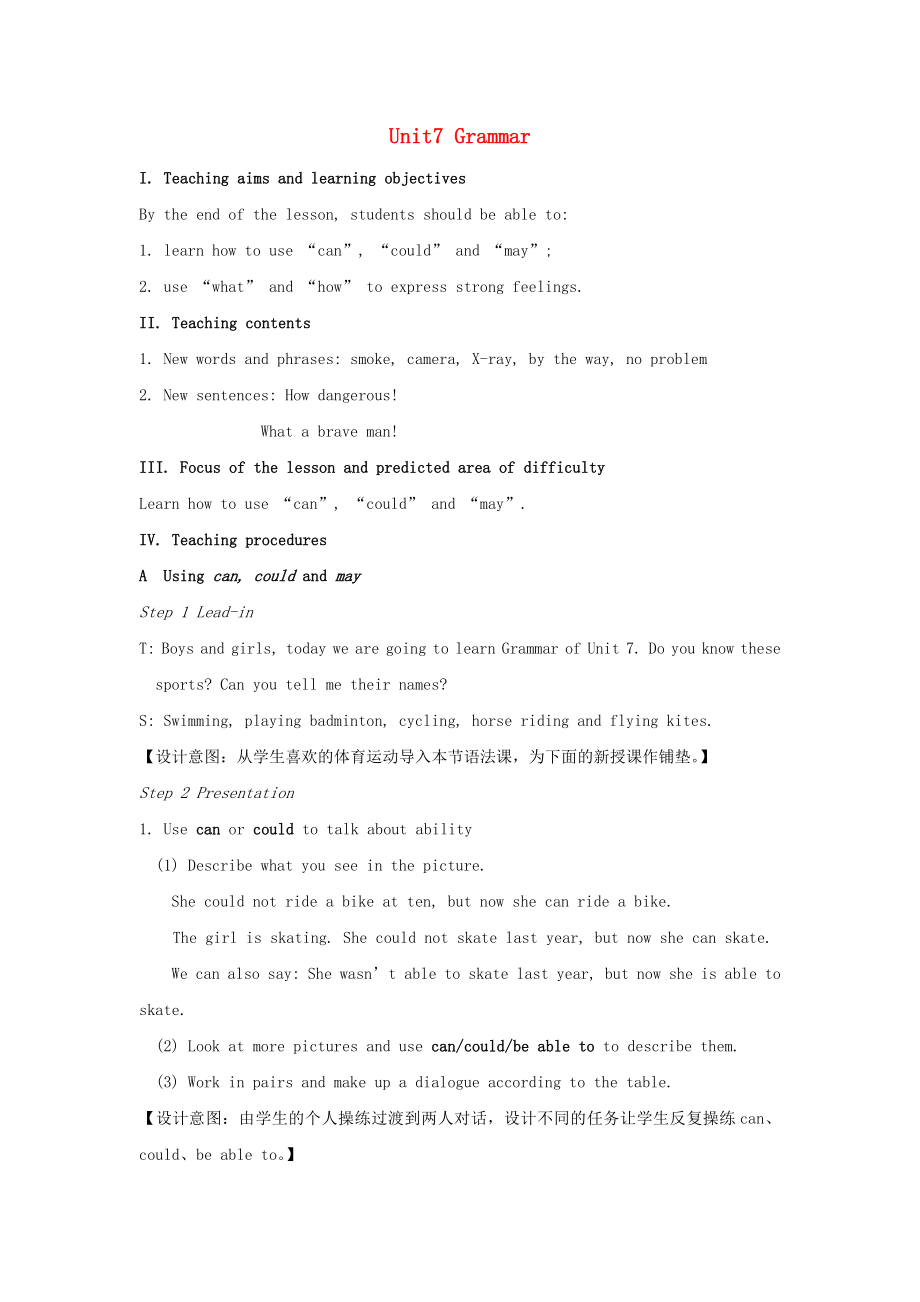《七年級(jí)英語下冊(cè) Unit 7 Abilities Grammar教案 (新版)牛津版》由會(huì)員分享�,可在線閱讀����,更多相關(guān)《七年級(jí)英語下冊(cè) Unit 7 Abilities Grammar教案 (新版)牛津版(5頁珍藏版)》請(qǐng)?jiān)谘b配圖網(wǎng)上搜索����。
1、Unit7 Grammar
I. Teaching aims and learning objectives
By the end of the lesson, students should be able to:
1. learn how to use “can”, “could” and “may”;
2. use “what” and “how” to express strong feelings.
II. Teaching contents
1. New words and phrases: smoke, camera, X-ray, by the way, no pr
2��、oblem
2. New sentences: How dangerous!
What a brave man!
III. Focus of the lesson and predicted area of difficulty
Learn how to use “can”, “could” and “may”.
IV. Teaching procedures
A Using can, could and may
Step 1 Lead-in
T: Boys and girls, today we are going to learn Gramm
3�、ar of Unit 7. Do you know these sports? Can you tell me their names?
S: Swimming, playing badminton, cycling, horse riding and flying kites.
【設(shè)計(jì)意圖:從學(xué)生喜歡的體育運(yùn)動(dòng)導(dǎo)入本節(jié)語法課,為下面的新授課作鋪墊�����?���!?
Step 2 Presentation
1. Use can or could to talk about ability
(1) Describe what you see in the picture.
She could
4、 not ride a bike at ten, but now she can ride a bike.
The girl is skating. She could not skate last year, but now she can skate.
We can also say: She wasn’t able to skate last year, but now she is able to skate.
(2) Look at more pictures and use can/could/be able to to describe them.
(3) Wo
5����、rk in pairs and make up a dialogue according to the table.
【設(shè)計(jì)意圖:由學(xué)生的個(gè)人操練過渡到兩人對(duì)話,設(shè)計(jì)不同的任務(wù)讓學(xué)生反復(fù)操練can�、could、be able to?�!?
(4) What do we use can/could to talk about?
T: Jacky Chen can act well.
Lu Xun could write wonderful articles.
Michael Jackson could sing and dance well.
Read th
6����、e sentences above and think about what we use can/could to talk about.
S: We use can/could to talk about ability.
T: Yes. We use can to talk about present ability and use could to talk about the ability in the past.
2. Use can, could or may to ask for permission
T: Read the dialogues below
7、carefully and tell me what we use can/could to talk about.
When talking with classmates or friends
A: Can we do after-school activities together?
B: Yes, of course.
When talking with teachers or parents
A: Could I hand in my homework later, Mr Lin?
B: Yes, you can./No, you can’t.
S: We use
8���、 can/could to talk about permission.
T: Which one sounds more polite, can or could?
S: Could sounds more polite than can.
T: You are right. In some formal occasions, we use may to ask for permission. For example:
A: May I have a talk with you, Mr Wu?
B: Yes, you may.
No, you may not./No, you c
9�����、an’t./ you mustn’t.
May is more polite than can/could.
【設(shè)計(jì)意圖:讓學(xué)生反復(fù)操練�,然后自己得出結(jié)論��?!?
3. Complete the conversation
T: Amy is talking with Mr Wu about her trip. Complete their conversation with can, could or may.
B Using what and how to express strong feelings
Step 1 Presentation
1. The trip to Sou
10、th Hill
T: The students’ trip to South Hill is wonderful. We can say “How wonderful the trip is!” to express our strong feelings. The sentence is called Exclamatory Sentence.
2. Have a try
T: Describe the pictures with what we’ve learnt today.
Picture 1: The girl is pretty.
How pretty the gir
11�、l is!
Picture 2: The boy is playing basketball happily.
How happily the boy is playing basketball!
T: The music sounds nice, isn’t it? Can you say it in another way?
S: How nice the music sounds!
T: Read the following sentences again.
How nice the music sounds!
How happily (the boy i
12、s playing basketball)!
How wonderful (the trip) is!
How pretty (the girl is)!
T: Nice, wonderful and pretty are adjectives, and happily is an adverb. So we can work out the structure of the exclamatory sentence: How + adj./adv. + (主語 + 謂語)�����!
【設(shè)計(jì)意圖:給出足夠多的例句����,讓學(xué)生自己得出感嘆句的句式結(jié)構(gòu)����?�!?
3. Jurassic World
13���、T: I watched a film called Jurassic World yesterday. It is very exciting. How exciting the film is!
What an exciting film (it is)!
4. Have a try
Picture 1: How pretty the girl is!
What a pretty girl she is!
Picture 2: How fine the weather is!
What fine weather it is!
Picture
14、 3: How beautiful the flowers are!
What beautiful flowers they are!
T: Read the following sentences again.
What a pretty girl (she is)!
What an exciting film (it is)!
What fine weather (it is)!
What beautiful flowers (they are)!
T: A pretty girl, an exciting film, fine weather a
15��、nd beautiful flowers are noun Phrases. Can you work out the sentence structure?
S: What + a/an + adj. + 可數(shù)名詞單數(shù)+(主語 + 謂語)�!
What + adj. + 不可數(shù)名詞 +(主語 + 謂語)!
What + adj. + 可數(shù)名詞復(fù)數(shù) +(主語 + 謂語)��!
Step 2 Practice
1. Complete the conversation on page 86
2. Complete the sentences with “What/What a/Wha
16���、t an/How”
heavy snow!
great abilities Superman has!
tall the trees are!
beautiful flowers they are!
amazing animal the ant is!
【設(shè)計(jì)意圖:在設(shè)計(jì)練習(xí)時(shí)�,通過圖片增加趣味性和生動(dòng)性�����,采用完成句子的形式降低題目的難度��。】
Step 3 Summary
T: Let’s see what we have learnt today?
S: Use “can/could/may” to talk about ability
Use “can/could/may” to talk about permission.
Use “what/how” to express strong feelings.
V. Homework
1. Write sentences with What ...!/How ...!;
2. Write sentences with can/could/may.
 七年級(jí)英語下冊(cè) Unit 7 Abilities Grammar教案 (新版)牛津版
七年級(jí)英語下冊(cè) Unit 7 Abilities Grammar教案 (新版)牛津版

